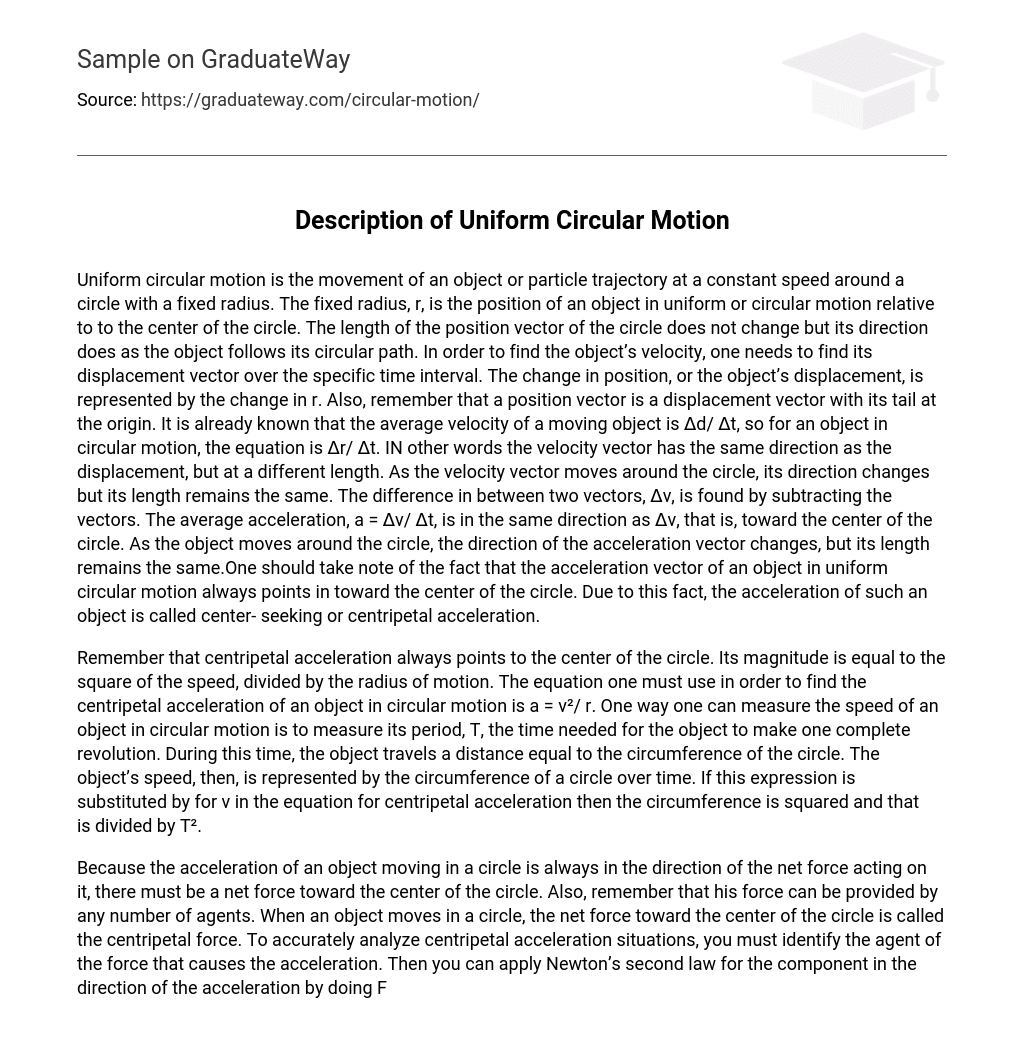Uniform circular motion is the movement of an object or particle trajectory at a constant speed around a circle with a fixed radius. The fixed radius, r, is the position of an object in uniform or circular motion relative to to the center of the circle. The length of the position vector of the circle does not change but its direction does as the object follows its circular path. In order to find the object’s velocity, one needs to find its displacement vector over the specific time interval. The change in position, or the object’s displacement, is represented by the change in r. Also, remember that a position vector is a displacement vector with its tail at the origin. It is already known that the average velocity of a moving object is ᐃd/ ᐃt, so for an object in circular motion, the equation is ᐃr/ ᐃt. IN other words the velocity vector has the same direction as the displacement, but at a different length. As the velocity vector moves around the circle, its direction changes but its length remains the same. The difference in between two vectors, ᐃv, is found by subtracting the vectors. The average acceleration, a = ᐃv/ ᐃt, is in the same direction as ᐃv, that is, toward the center of the circle. As the object moves around the circle, the direction of the acceleration vector changes, but its length remains the same.One should take note of the fact that the acceleration vector of an object in uniform circular motion always points in toward the center of the circle. Due to this fact, the acceleration of such an object is called center- seeking or centripetal acceleration.
Remember that centripetal acceleration always points to the center of the circle. Its magnitude is equal to the square of the speed, divided by the radius of motion. The equation one must use in order to find the centripetal acceleration of an object in circular motion is a = v²/ r. One way one can measure the speed of an object in circular motion is to measure its period, T, the time needed for the object to make one complete revolution. During this time, the object travels a distance equal to the circumference of the circle. The object’s speed, then, is represented by the circumference of a circle over time. If this expression is substituted by for v in the equation for centripetal acceleration then the circumference is squared and that is divided by T².
Because the acceleration of an object moving in a circle is always in the direction of the net force acting on it, there must be a net force toward the center of the circle. Also, remember that his force can be provided by any number of agents. When an object moves in a circle, the net force toward the center of the circle is called the centripetal force. To accurately analyze centripetal acceleration situations, you must identify the agent of the force that causes the acceleration. Then you can apply Newton’s second law for the component in the direction of the acceleration by doing F = ma. When solving problems, one has found it useful to choose a coordinate system with one axis in the direction of the acceleration. For circular motion, the direction of the acceleration is always toward the center of the circle. Rather than labeling this axis x or y, call it c, for centripetal acceleration. The other axis is in the direction of the velocity, tangent to the circle. Remember that centripetal force is just another name for the net force in the centripetal direction.Remember that if you cannot identify the agent of the force, then the agent does not exist.The so-called centrifugal, or outward force, is a fictitious, non existent force. Newton’s laws are able to explain motion in both straight lines and circles. Now you know all there is to know about circular motion and its many components.





